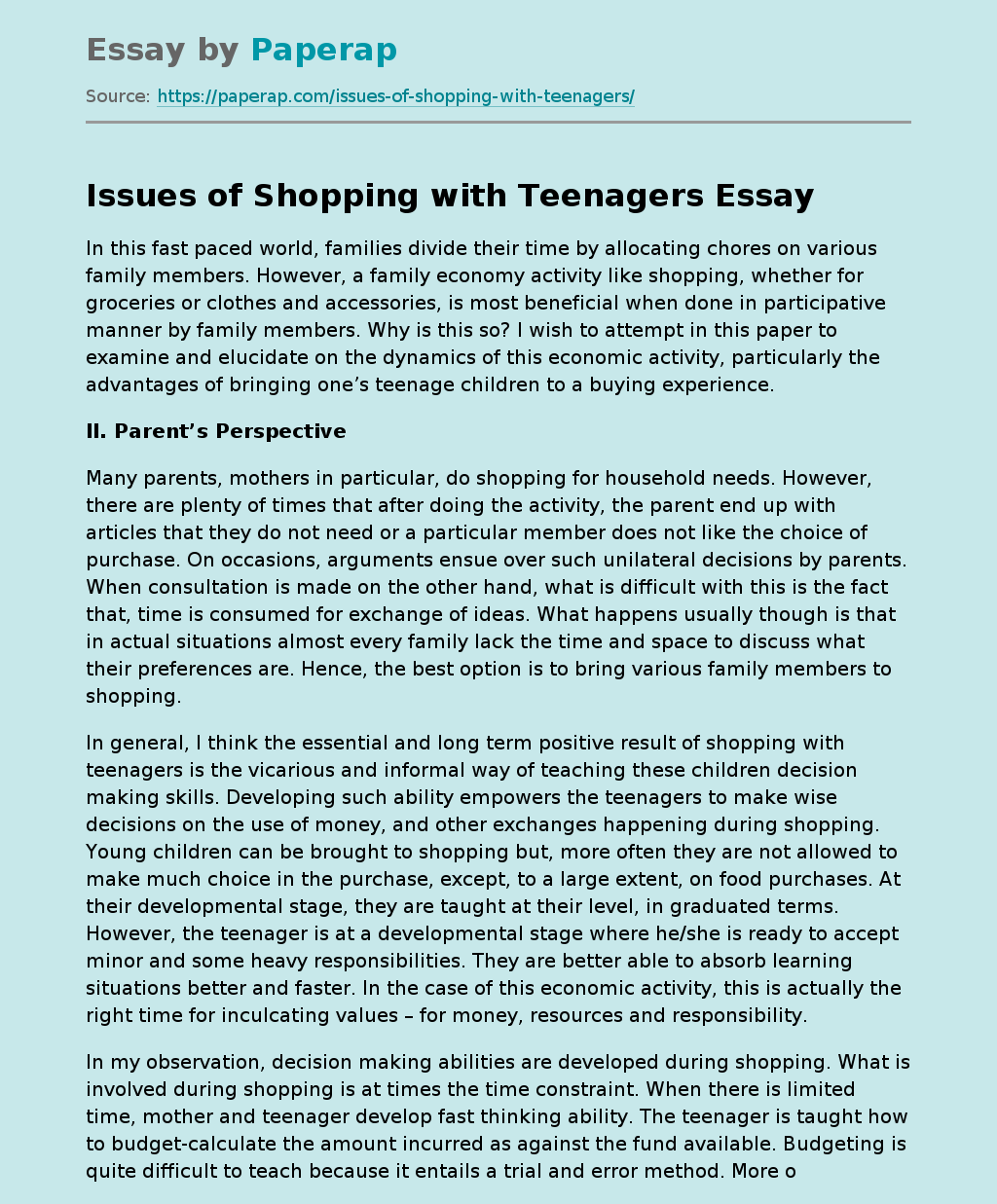Issues of Shopping with Teenagers
In this fast paced world, families divide their time by allocating chores on various family members. However, a family economy activity like shopping, whether for groceries or clothes and accessories, is most beneficial when done in participative manner by family members. Why is this so? I wish to attempt in this paper to examine and elucidate on the dynamics of this economic activity, particularly the advantages of bringing one’s teenage children to a buying experience.
II. Parent’s Perspective
Many parents, mothers in particular, do shopping for household needs.
However, there are plenty of times that after doing the activity, the parent end up with articles that they do not need or a particular member does not like the choice of purchase. On occasions, arguments ensue over such unilateral decisions by parents. When consultation is made on the other hand, what is difficult with this is the fact that, time is consumed for exchange of ideas. What happens usually though is that in actual situations almost every family lack the time and space to discuss what their preferences are.
Hence, the best option is to bring various family members to shopping.
In general, I think the essential and long term positive result of shopping with teenagers is the vicarious and informal way of teaching these children decision making skills. Developing such ability empowers the teenagers to make wise decisions on the use of money, and other exchanges happening during shopping. Young children can be brought to shopping but, more often they are not allowed to make much choice in the purchase, except, to a large extent, on food purchases.
At their developmental stage, they are taught at their level, in graduated terms. However, the teenager is at a developmental stage where he/she is ready to accept minor and some heavy responsibilities. They are better able to absorb learning situations better and faster. In the case of this economic activity, this is actually the right time for inculcating values – for money, resources and responsibility.
In my observation, decision making abilities are developed during shopping. What is involved during shopping is at times the time constraint. When there is limited time, mother and teenager develop fast thinking ability. The teenager is taught how to budget-calculate the amount incurred as against the fund available. Budgeting is quite difficult to teach because it entails a trial and error method. More often, errors result rather than the precision and correct choices made. If parents get stressed out teaching their teenagers this process, children would end up not learning what and how to buy critically. The aim of every parent for teenagers is for their children to buy things or food, with quality, less cost and durability in mind.
III. Teenagers’ Perspective
To me, money and possession of it entails responsibility. If at this stage, the teenage son or daughter has not learned important elements of the use of their money and the money earned by their parents, a lifetime of difficulty, even poverty, is a real possibility. What makes this shopping a way of teaching the adolescent children is the fact that it is a leisure activity for children. Inherent in every shopping is its enjoyable experience; an aspect which can be utilized to help make the experience a learning one.
For every teenager, I believe that shopping is thoroughly pleasurable. I even overhear a neighbor and her teenage son doing shopping together and her son (who obviously enjoyed this) refer this experience together as “pleasure.” He would say to his mom,
“Mom, can we go to ‘pleasure’ today?”
Probably, it is simply because, he can be with his mother the whole time; lapping it all up, so to speak. The fact that he is a middle child among two other siblings might probably his reason to make these trips with mom such a pleasant experience.
Lastly, it is my belief, from personal experience, that having the purchasing power is important to a teenager. Even when mom is around, he or she is afforded the opportunity to make the choice about what should be purchased. It gives the person a sense of personal satisfaction.
IV. Conclusion
I cannot deny that shopping with adolescent children is not difficult also, nor does it have only the plus side. Shopping with teenage children can mean headache to a mother or parent. The teenager in his/her generation prefers things or food that parents do not approve of more often. They may dress up differently or be influenced by media to choose food that have empty calories. Unless the mother knows how to bargain and make compromises, shopping malls can turn out to be battlefront for families.
In my opinion, a shopping activity helps cement relationships and enables teenage children to talk with parents. It is accepted that this stage is wrought with changes that throw a teenager into confusion and wrong choices which will mark him/her for life. It is precisely for this reason that I believe, every parent utilizes any opportunity to make and spend time with any activity to be together with their children.
If the only time available is shopping, then I, if I am a parent, should grab that every available chance to enlist my teenager to go shopping with me. I can even make it a point to create occasions just to afford my teenager the attention and presence that I can give. What better way than that which is enjoyable for him/her also? Shopping together is then such a perfect prospect for the both of us.
Issues of Shopping with Teenagers. (2019, Dec 05). Retrieved from https://paperap.com/issues-of-shopping-with-teenagers/

